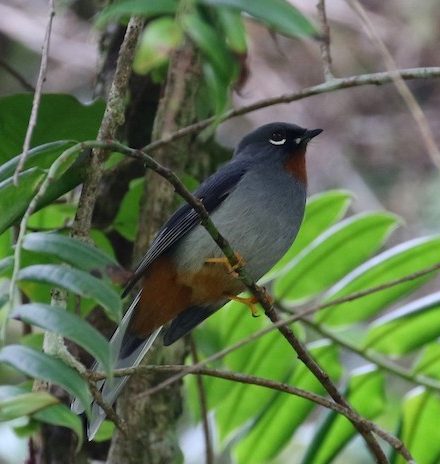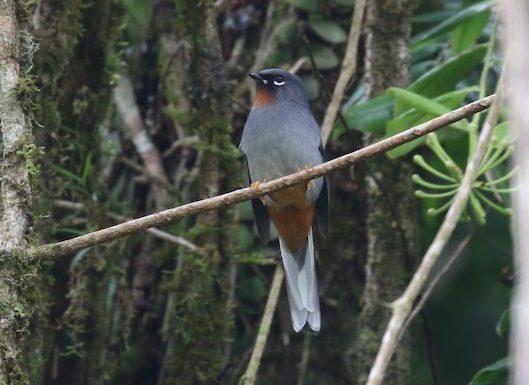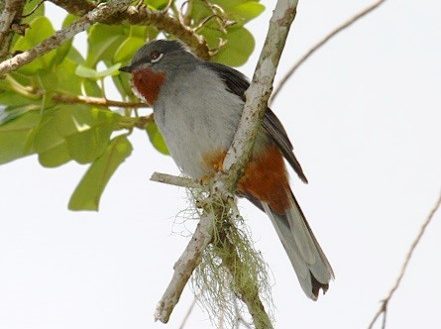Birdfinding.info ⇒ The distinctive Jamaican endemic form of Rufous-throated Soltaire is easily heard, but not always easy to see, in the early morning at Hardwar Gap and other Blue Mountain sites. It can sometimes be found at other locations, including Ecclesdown Road, San San, and wet forest sites in Cockpit Country, but far less reliably.
“Jamaican Solitaire”
Myadestes genibarbis solitarius
Endemic to Jamaica, where it occurs in humid montane and foothill forests.
Breeds mainly at upper elevations of the Blue, Port Royal, and John Crow Mountains. May also breed locally in low densities or sporadically in the western and central highlands. When not breeding—mainly November to March—disperses to a wider range of elevations the length of the island.
Identification
Unique and distinctive: slate-gray upperparts and pale gray underparts, with bright rufous throat and vent, and a white crescent below the eye. Also has small white dots on the chin and beside the base of the bill.
The outer tail feathers are largely white (but this is not always visible), and the spread wing shows a white bar at the base of the flight feathers.

“Jamaican Solitaire,” M. g. solitarius. (Hardwar Gap, Jamaica; January 29, 2019.) © Matthew Grube

“Jamaican Solitaire,” M. g. solitarius. (Hardwar Gap, Jamaica; March 10, 2017.) © Larry Therrien

“Jamaican Solitaire,” M. g. solitarius. (Hardwar Gap, Jamaica; January 29, 2019.) © Michael Woodruff

“Jamaican Solitaire,” M. g. solitarius. (Hardwar Gap, Jamaica; July 8, 2008.) © Steve Metz

“Jamaican Solitaire,” M. g. solitarius. (Hardwar Gap, Jamaica; January 28, 2019.) © Matthew Grube
Notes
Monotypic form that is traditionally regarded as a subspecies of Rufous-throated Solitaire.
Frontiers of Taxonomy: the Rufous-throated Solitaire Complex. A mitochondrial DNA study (Miller et al. 2007) of Myadestes found that the “Jamaican Solitaire” is more distantly related to the subspecies of Hispaniola, Dominica, Martinique, and St. Lucia than they are to one another. The study also found that its relationship to other forms of Rufous-throated Solitaire is more distant than that between the Black-faced and Varied Solitaires of Central America. This research suggests that the “Jamaican Solitaire” may be best regarded as a separate species. The researchers did not have access to tissue samples from the “St. Vincent Solitaire” and were therefore unable to analyze its genetic distance from the other forms.
References
Collar, N. 2019. Rufous-throated Solitaire (Myadestes genibarbis). In Handbook of the Birds of the World Alive (J. del Hoyo, A. Elliott, J. Sargatal, D.A. Christie and E. de Juana, eds.). Lynx Edicions, Barcelona. https://www.hbw.com/node/58239. (Accessed April 29, 2019.)
eBird. 2019. eBird: An online database of bird distribution and abundance. Cornell Lab of Ornithology, Ithaca, N.Y. http://www.ebird.org. (Accessed April 29, 2019.)
Haynes-Sutton, A., A. Downer, R. Sutton, and Y.-J. Rey-Millet. 2009. A Photographic Guide to the Birds of Jamaica. Princeton University Press, Princeton, N.J.
Miller, M.J., E. Bermingham, and R.E. Ricklefs. 2007. Historical Biogeography of the New World Solitaires (Myadestes Spp.). Auk 124:868-885.
Raffaele, H., J. Wiley, O. Garrido, A. Keith, and J. Raffaele. 1998. A Guide to the Birds of the West Indies. Princeton University Press, Princeton, N.J.
